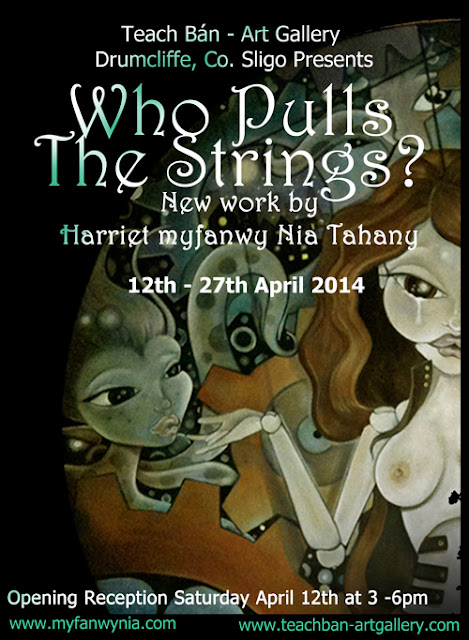'Who Pulls The Strings?'
Solo Show at
Teach Ban Art Gallery, Drumcliffe Co. Sligo!
This April 12th - 27th 2014
Click on the poster image above to RSVP on facebook!
This
12th to 27th April I will be showing my 'Who Pulls The Strings?
Exhibition in Co. Sligo at Teach Bán - Art Gallery - Drumcliffe, Sligo,
Ireland.
This new collection was premiered at Temple Bar, Dublin's White Lady Art gallery between the dates of July 4th – 27th 2013.
Press Release:
Teach Bán - Art Gallery - Drumcliffe, Co. Sligo, Ireland
New work by Harriet Myfanwy Nia Tahany
Who Pulls The Strings?
Opening reception Saturday 12th of April 2014 3pm - 6pm
Teach Bán
- Art Gallery - Drumcliffe, Sligo will be presenting a new exhibition
by Irish Pop Surrealist - Harriet Myfanwy Nia Tahany, from April 12th –
27th 2014.
Harriet
a recipient of the RDS Taylor award, received her degree in 2007 from
Sligo IT and graduated from the University of Ulster in 2009 with a
Masters in Fine Art. Harriet has exhibited in Dublin, Belfast and Sligo.
This new body of work includes paintings, drawings and prints with a
Jungian theme, exploring concepts derived from an esoteric
interpretation of the classic children’s story Pinocchio.
Jung
believed that, to be psychologically healthy, one must strike a balance
between the demands of society and what we really are, in being
oblivious to one’s persona he believed that to be underestimating the
importance of society, but to be unaware of one’s deep individuality, is
to become society’s puppet.
‘Who
Pulls The Strings?’ is an exhibition based on this Jungian notion, an
exploration of ideas and narratives set in a psychedelic dreamscape
depiction of puppet characters in a metaphysical world.
Harriet
is well known for her ongoing exploration of themes inspired by
‘hermeneutics’, the art of literal translation, in attention to
characters, events and symbols in a story’s underlying structure, often
with a particular emphasis on fairytales and mythology. In this new body
of work we see Harriet expand her artistic depictions of story analysis
into the exploration of allegory, a device used widely in histories of
all forms of the arts because of its immense power to illustrate complex
ideas and concepts in ways that are easily accessible and tangible to
an audience.
Harriet
has focused on esoteric concepts from Carlo Lorenzini’s classic story of
Pinocchio and the more famously adapted version in the 1940's Disney
classic. This story of a wooden puppet that comes to life conceals
spiritual allegory with roots in the mystery schools of occultism.
Harriet explains further:
“The children’s story about “being good” and ”not lying” as allegory becomes the quest for wisdom and spiritual enlightenment. Crammed with timeless and honest social commentaries, Pinocchio depicts a very unsettling vision of our modern world and prescribes, perhaps, a way to escape its traps. Striving to achieve a higher level of spirituality through self-improvement is a very universal theme found in most religions. Pinocchio’s allegory exposes itself as typically Masonic and reveals the philosophical background of those in control of the mass media.”
“The children’s story about “being good” and ”not lying” as allegory becomes the quest for wisdom and spiritual enlightenment. Crammed with timeless and honest social commentaries, Pinocchio depicts a very unsettling vision of our modern world and prescribes, perhaps, a way to escape its traps. Striving to achieve a higher level of spirituality through self-improvement is a very universal theme found in most religions. Pinocchio’s allegory exposes itself as typically Masonic and reveals the philosophical background of those in control of the mass media.”
We see
these themes illustrated in Harriet’s new work through depictions of
journeys into inner metaphysical worlds, described by decorative
psychedelic patterns of circular motifs.
The
puppet characters who are all females, are contemplative of this artists
own individuality and “dark alluring forces of a vast collective
consciousness, that is the Mass Media; filtering into the collective
unconsciousness and swaying them from discovering who they really are.”
They appear tainted with a sweet yet sinister confusion, through the
unsettling juxtaposition of imagery stylistically inspired by “popular
toy culture and fashion as being the invisible strings that control
them.”



